If you’re managing construction projects, you already know that effective communication between project stakeholders on all levels is essential for success.
When communication between the participants is disorganized, unclear, or restricted, construction projects are prone to confusion, errors, mix-ups, conflicts, and blame-shifting, leading to delays and budget overruns, or even their failure.
So, how can you unlock this complex mechanism of project interactions and establish effective jobsite communication with your construction team?
Here are the keys.
In this article...
Determining Communication Responsibilities
Determining communication responsibilities goes hand-in-hand with assigning clear roles and responsibilities in construction projects.
In other words, a clear chain of command is a prerequisite for effective communication throughout the project lifecycle.
According to a survey, poor communication and incorrect project information cause almost half of all rework on construction projects worth billions of dollars.
It follows that determining clear lines of communication, where information is not lost between all the different project stakeholders, is crucial for keeping the project budget and schedule under control.
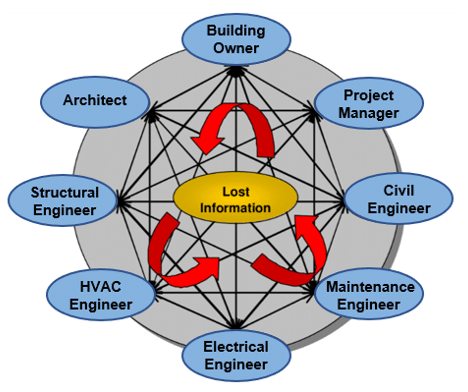
As the nature of construction projects creates a complex communication environment of fluctuating contractual and personal relationships, you first need to clearly define the roles and responsibilities of everyone involved in the project.
To do that, break down the project into clear tasks, milestones, and deliverables.
Then assign the responsibility for performing each task, subtask, or activity to different roles executed by one (e.g., the site manager) or more people (e.g., the subcontractor’s team).
The best way to determine everyone’s communication responsibilities will be is by using a RACI chart, which ensures you and all other project stakeholders know exactly who is “Responsible, Accountable, Consulted, and Informed,” like in this example:
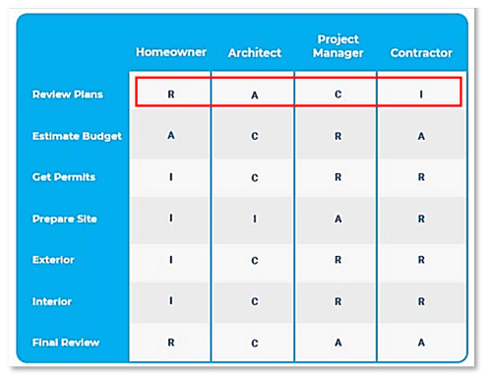
For instance, the homeowner is responsible for reviewing the plans and approving them, but the architect who designed their new home is accountable for the final design.
Finally, the project manager should be consulted, and the contractor informed that they can start their work.
Naturally, each of these project stages can be broken down into a more detailed list of tasks with assigned roles and responsibilities to get a clear picture of who should communicate what to whom.
When done, you’ll need to align the roles and responsibilities assigned in the RACI matrix with your construction team members and other project stakeholders and get their buy-in.
Once names are connected to the roles and responsibilities assigned, you’ll have a clear chain of command between all stakeholders.
That way, communication responsibilities are easily determined, thus avoiding costly mix-ups, and omissions so common in construction projects.
Having Communication Tools
Of course, a clear communication chain of command works best in combination with efficient communication tools.
Nowadays, along with a host of available team communication, messaging and file-sharing apps, there are specialized tools that facilitate the exchange of information between construction team members throughout all stages of a construction project.
For example, using Building Information Modeling (BIM) enabled software to create a digital 3D model of a building’s physical and functional features is probably the most powerful tool in the construction industry’s new toolbox.
However, BIM also enhances communication between all project stakeholders and team members. It does so in different ways, showed here courtesy of eSub:
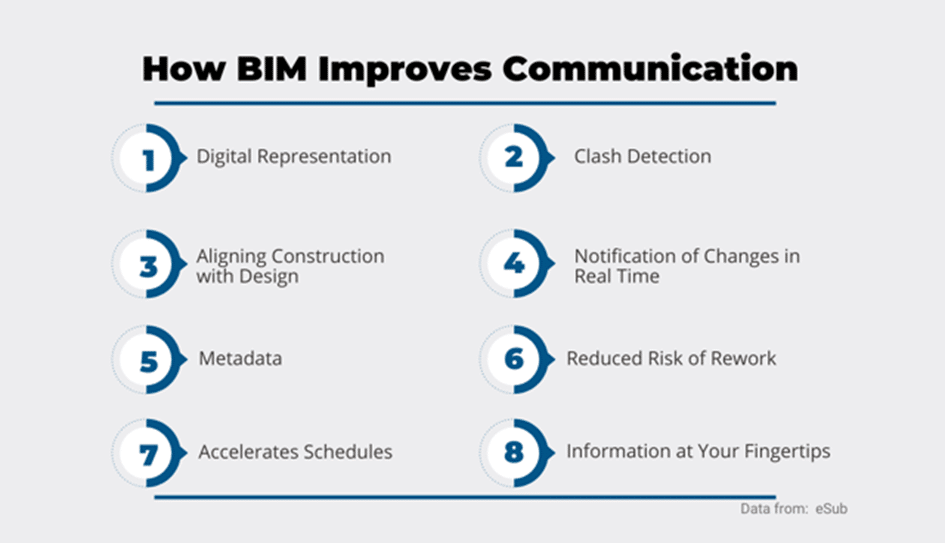
Let’s take clash detection. As BIM can integrate data prepared by various stakeholders into a single model, it can detect clashes between different construction elements, such as ducting or piping conflicts.
If there’s a clash, it’s caught in the design phase, then communicated to the construction team, which means it can be addressed appropriately.
BIM also aligns construction with design by allowing collaboration between the design team and contractors who can give their input and help designers develop better (more practical, less expensive) designs.

Of course, many other construction management software solutions can streamline all or specific construction project workflows, thus facilitating team communication.
Even some more specialized software tools, like those for equipment management, can make jobsite communication within your construction team more effective.
For example, when your construction workers check out a piece of equipment, they can scan it with a smartphone and see messages left by other team members about its general condition and specific quirks while also getting useful information like its last service date, last known location, and previous user.
If you want to do this in a simple and affordable way, try our equipment tracking software, GoCodes.

In this case, team communication is facilitated by providing information necessary for the smooth running of a construction project (by tracking where tools and equipment are) and allowing workers to comment and advise their co-workers on using a specific piece of equipment.
In conclusion, clear communication lines should be supported using the right communication tools and other software solutions, whether specific or comprehensive.
That facilitates collaboration between construction team members.
Keeping Your Messages Simple
As said, construction projects create complex communication environments. To avoid complications and confusion, you should keep your messages simple, direct, and concise.
Despite advanced communication and management tools and other technologies propelling the construction industry forward, projects are still susceptible to issues arising from differing communication styles.
For example, you might think the instructions you gave to a subcontractor on how to handle a specific job were simple and clear.
Still, things might turn out differently if you were in a hurry and didn’t make sure they understood exactly what needed to be done and what the next steps were.
That’s because every message you communicate (face-to-face, in writing, or online) goes through two frames of reference—in this case, yours and the subcontractor’s—which might be different, and consequently, so can the interpretation of your message.
Here’s just a quick reminder of how important effective (clear, simple, and concise) communication is on construction projects, courtesy of Pro Crew Schedule:
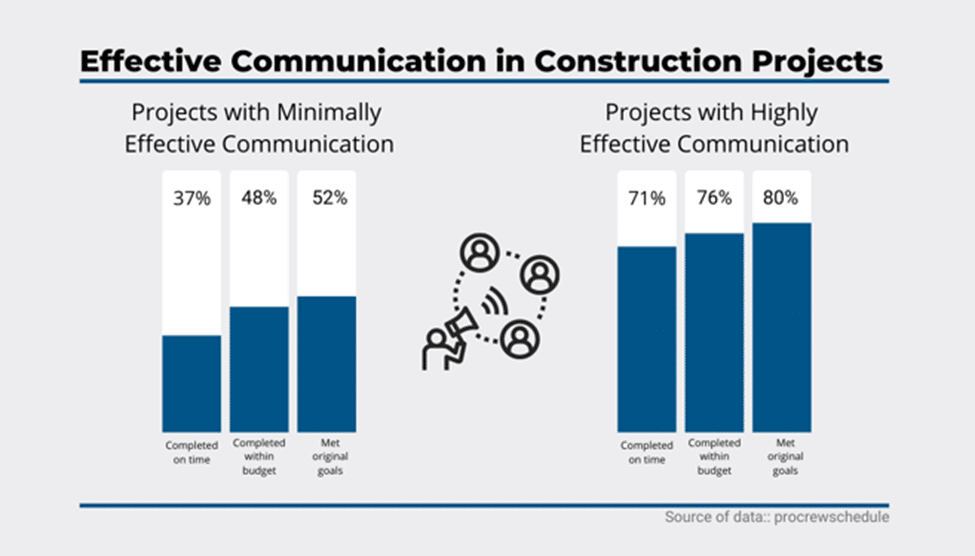
These statistics highlight the vast difference effective communication makes, minimizing all other risks, constraints, and issues inherent to construction projects.
So, even if you ensured clear roles and responsibilities, assigned tasks and communication responsibilities, and provided communication tools for your construction team, always remember to check whether the person on the other side of the conversation interpreted your message in the way you intended, and knows exactly what steps to take.
The best way to do it in face-to-face or online conversations is to ask them to tell you what they heard in their words.
In written communication like email or messaging, you can ask for confirmation of understanding or ask questions that will produce the same result.
Overall, just stick to the facts, don’t overcomplicate or overelaborate, adjust your communication to different individuals or teams to get your point across effectively, and keep your messages simple, direct, and concise.
Encouraging Others to Talk
Effective communication is a two-way street. In other words, the quality of team interactions often depends on you saying less, encouraging others to talk, and listening more.
Active listening will build trust and make team members feel heard, allowing you to get feedback and gather professional opinions and ideas that can benefit the entire team and contribute to successful project completion.
Moreover, in the words of Harvard’s Rick Fulwiler:
“Effective listening will help you “sell” your technical skills by allowing you to explain and utilize those skills in a way others understand.”
In other words, actively listening and encouraging others to participate and give their opinions will ultimately help your messages be better understood, allowing you to use your management skills more efficiently.
You can read more about how effective listening improves your leadership in the article shown below.

For instance, when you encourage a team member to express their opinion, active listening would imply you’re actually focused on what they’re saying and not distracted by thinking of an answer or what you’ll have for lunch.
It also implies you’re trying to understand not only their words but the meaning behind them, observing non-verbal cues and asking questions to check understanding.
Furthermore, in view of long-standing skilled labor shortages, recruitment issues, and other challenges the construction industry is facing, a wise manager’s communication skills should, now more than ever, include skills like active listening, empathy, and emotional intelligence along with proficient use of different communication tools and methods.
Remember, encouraging others to talk and truly listening to them will enhance jobsite communication by building trust and providing valuable insights and feedback, ultimately strengthening your leadership.
Documenting Conversations
As construction projects grow in complexity, so do the reasons for documenting conversations, changes, and decisions throughout the project lifecycle.
Similar to how it improves communication, construction management software can streamline this process to benefit all project stakeholders and ensure everybody’s on the same page.
Remember, whether during a phone call, face-to-face meeting, or video conference, not all participants will remember what was said, what conclusions were made, or clearly understand what they should do about it.
This results in confusion, which can have detrimental effects like lost time, errors, substandard work, delays, rework, and cost overruns.

Thus, it’s important to take notes during conversations, writing down findings, decisions, required actions, and potential issues.
Those can then be used to create brief follow-ups with action lists, and sent to relevant stakeholders. Don’t forget to request that they sign off on them, either.
On top of that, keep in mind that inconsistent, unclear, incomplete, or delayed reporting of ongoing project issues, their solutions, and required changes to all relevant parties, or giving vague directions to your crew members, will further add to misunderstandings and lower jobsite productivity.
Nowadays, construction project management software allows you to document and record all communication and streamline the entire process by, for instance, providing a single source of information that all participants can use to check whether they understood or interpreted something correctly.
This minimizes the need for the search for information that can hamper team workflows.
By the way, the same is achieved when clear communication lines are drawn using the RACI chart we mentioned above.
A good example of software that enables centralized communication on all levels is Procore.
It essentially allows you to store documents, records, blueprints, and RFIs from the field and office teams.
It allows you to update them, ensuring that everyone has access to the most current project information.
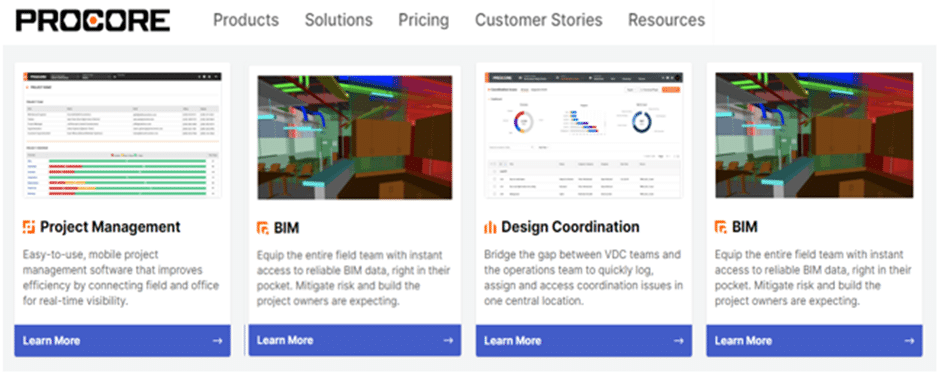
Thus, to avoid miscommunication and confusion derailing your project, you should document conversations, key takeaways, and decisions.
You should do that by using the right construction management software that provides a single source of truth for all project stakeholders and streamlines all project communications.
Conclusion
To sum up, the keys that will unlock communication with your construction team start with determining communication responsibilities and ensuring the use of software and other tools that streamline project communications.
When that’s followed by keeping your messages simple, encouraging others to talk, and documenting conversations, you’re set for effective jobsite communication with your team.





